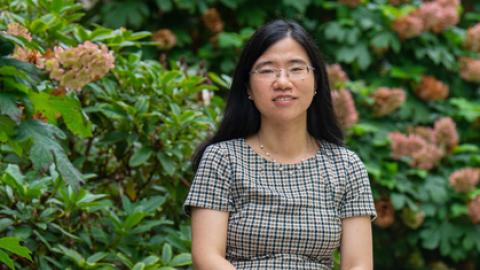
Reshaping a piece of wood may conjure images of wood-carving or whittling, but more recent pursuits have attempted to break down the cellular structures within wood to create more sustainable and durable materials.

A new study published in Science details an innovative new process that breaks down the wood’s cell walls and allows the material to be reconstituted via a “water-shock” treatment.
The study, led by a research team at the University of Maryland including Yuan Yao, assistant professor of industrial ecology and sustainable systems at YSE, started by breaking down the wood’s lignin component — the wood’s cell walls that give it strength. The broken fibers were then closed by evaporating water, then the wood was “re-swelled” in “a rapid water-shock process that selectively opens the vessels.”
The resulting material has a wrinkled cell wall structure that allows the material to be molded into desired shapes as 3D-molded wood — with a constitution six times stronger than the original wood material and comparable to other lightweight materials, like aluminum alloys.
The strong mechanical property, the research team says, could “widen wood’s potential as a structural material, with lower environmental impact for buildings and transportation applications.”
Yao, a faculty member at the Center for Industrial Ecology, performed a critical life-cycle assessment (LCA) to understand the environmental impacts of 3D-molded wood compared to aluminum alloy. LCA is a critical tool used in industrial ecology to quantify the environmental implications of a product across its life cycle.
Yao also used LCA to determine if the process could be optimized from a sustainability perspective. She identified that the largest contributor to the overall environmental impact would be the energy usage of the wood treatment, which could be reduced greatly by shortening the processing time.
Because further studies must be conducted to determine the impact of large-scale applications, Yao says, future research will investigate the potential impact this technology and broad applications could have on the forests.
“We are considering where the wood should come from, how we can use this process to support sustainable forest management practices, and how this process would affect current wood supply and demand,” Yao says.

Yao’s research examines the environmental and economic impacts of emerging technologies and industrial processes, integrating interdisciplinary approaches from the fields of industrial ecology, sustainable engineering, and systems modeling to develop techniques that promote more sustainable engineering approaches and policies. She led a groundbreaking study earlier this year that created a high-quality bioplastic from wood byproducts that is recyclable, biodegradable and has a lower life-cycle environmental impact.
Earlier this month, Yao was named a recipient of the Laudise Medal from the International Society of Industrial Ecology, given for outstanding achievements in industrial ecology by a researcher under the age of 36.
Published
November 8, 2021